By Gina Mapua
Trip One
Last November 28 and 29, under the aegis of the Philippine Native Plant Conservation Society Inc. (PNPCSI), Atty. Ipat Luna, Architect Rey Solero and just-plain-old-me conducted an initial survey of Lorelei Island, located within the Verde Island passage. Lorelei island is actually three islands. Two islands, a large one and a smaller one, are joined by a substantial sandbar. The third “island” is just a coral reef that barely juts out of the water. Our goal was to survey the islands’ vegetation to determine if it has the potential for the PNPCSI to consider conducting a project on the island.
After an 18-minute banca ride, we offloaded onto a rocky beach and set up camp. There were very few amenities on the island. There was a house built of stone and cement that lost its roof to a typhoon, and there was a sort of shack in worse condition. At least there was a toilet, although the typhoon blew the door and roof off too. We all had to time our trips to the loo most judiciously.
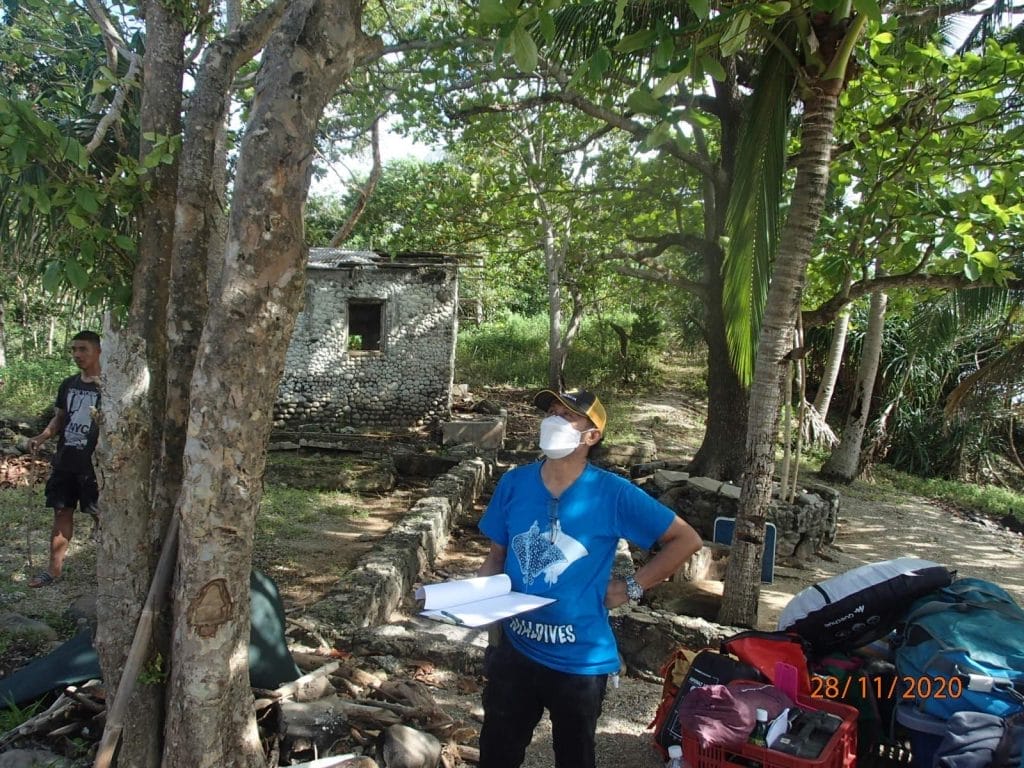
The first thing we noticed was the tall salimbobog or balai lamok (Cratevea religiosa) in full bloom right behind the stone house. Rey was so delighted he dropped everything to give the tree his full inspection.
After a quick meal, we divided the terrain for each of us to quickly survey before the sun set. The big island was divided into areas A and B, while the smaller island was area C. Rey took A, I took B and Ipat took C.
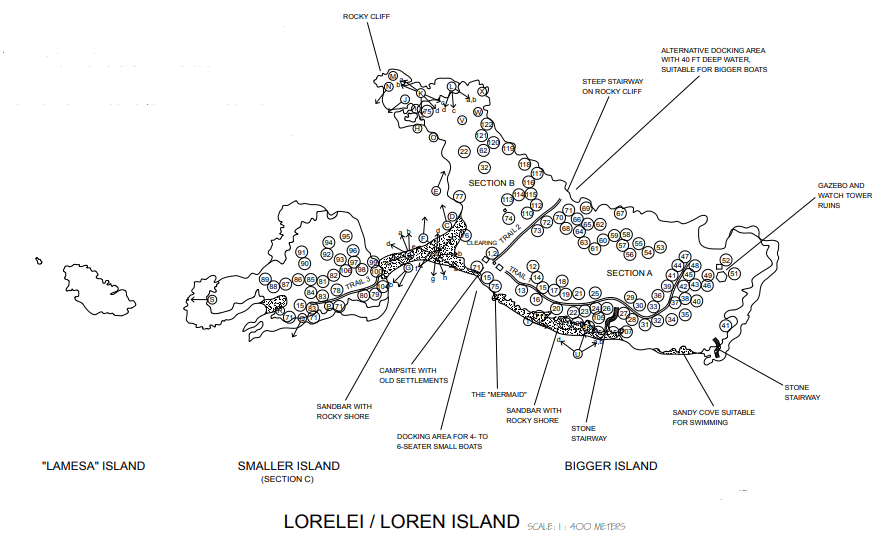
Note that not one of us were botanists of any sort. We could identify only the most commonly known trees, while our guides helped us identify a few more. Noteworthy were the calumpangs (Sterculia foetida) that dramatically leaned out over the steep cliffs, especially on the northeastern side of the large island, large areas dominated by pandan (Pandanus tectorius), and the buri palms (Corypha utan) that stood above the canopy on both islands. Other trees were malakalumpang (Sterculia ceramica), talisay (Terminalia catappa), molave (Vitex parviflora), narra (Pterocarpus indicus), bayok (Pterospermum diversifolium), himbabao (Broussonetia luzonica), dapdap (Erythrina variegata), lanete (Wrightia pubescens), bani (Milletia pinnata) and noni (Morinda citrifolia). But there were also alien/non-native species as well: mahogany, ipil-ipil, gmelina, and Acacia falcata in particular.
After a dinner of grilled fish and fried calumpang seeds (they are edible!), Ipat and Rey retired to their own tents while I settled into my hammock tied between a bani and a talisay tree. From our campsite we could see the stars and watch the moon rise and set.

The next day, while Rey continued to survey the vegetation, I decided to look around for other life. I had already counted 15 bird species and reported my sightings on eBird. The species I identified were the usual suspects also found on the mainland. I caught fleeting views of a pigeon species but was unable to identify them. Notable were the two Brahminy kites that were nesting in area B. Fortunately, area B has no trails for humans to readily access the area and so the birds are relatively undisturbed.
I checked out the sandbar and rock pools for marine life. Limpets the size of 10-peso coins clung to the rocks. I have not seen limpets these large. But what really surprised me was the variety of corals all strewn about. I even found a sizeable sponge, which we used to wash dishes with, since we had forgotten to bring a dish sponge. And while the variety of coral was impressive, I suspect the reason why such a large variety in sizeable pieces comprise the sandbar is because of dynamite fishing. Still, the waters around the island are lush with life. One of our guards named Ahmad waded out into the water and in less than 10 minutes came back with a bucket of grape seaweed for our salad.
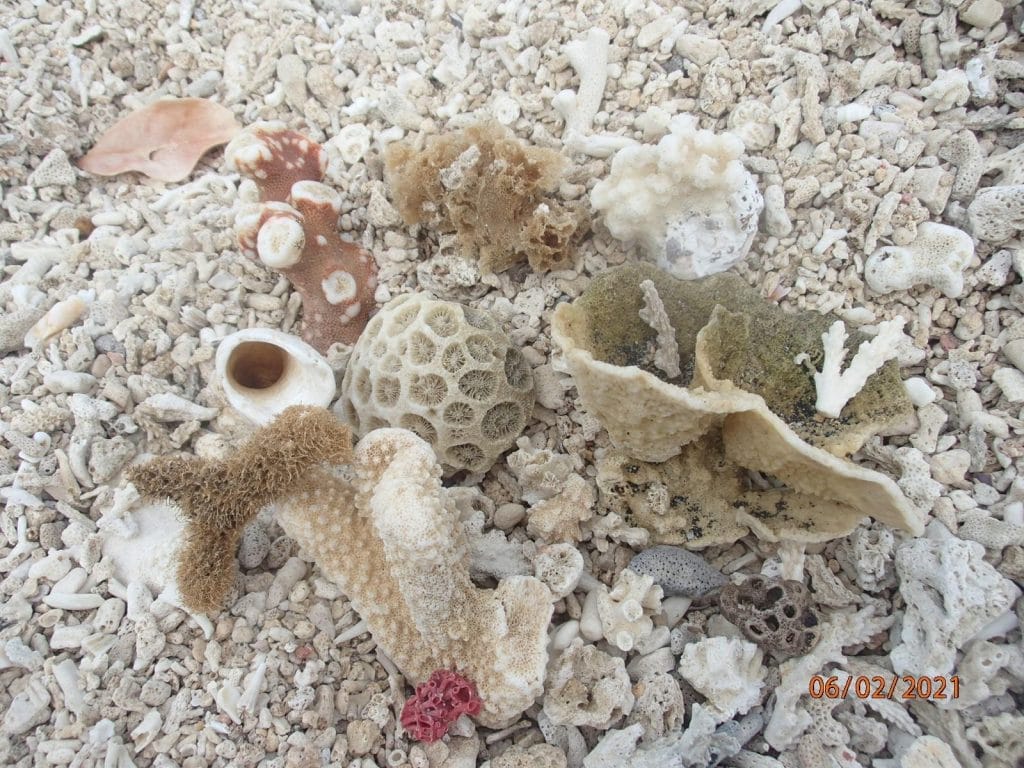
Our conclusion was that the islands were essentially botanically sound and we would recommend to the PNPCSI board to look into developing projects for the island.
Trip Two
We realized we needed actual plant people, rather than the novices that Ipat, Rey and I were for a more thorough survey of the islands. For our next trip to the island on 6 to 7 February, we recruited PNPCSI heavy guns like Ronald Achacoso, Edwin Tadiosa, and Noel Malacad and the difference was immediately heard. As we walked the trails, we didn’t hear local names of plants, we heard scientific names.
All in all, we identified 81 plants species. List is below. But there are many more species that need identification.

From left: Edwin Tadiosa, Gina Mapua, Rey Solera, Ronald Achacoso, Noel Malacad
Ronald pointed out a small low plant with rounded, deep green leaves and called it a Binangonan kamuning. He said it wasn’t really a kamuning but it was a popular bonsai plant. The plant is beginning to disappear from the wild due to demand from the bonsai market. Species name is still unclear.
We were able to identify many beach forest species but nothing outstanding or rare. The island’s caretaker named Vic had earlier released six goats on the islands. And while we saw neither hide nor hair of them, we saw signs of them: gnawed tree bark, truncated bushes and narrow little trails through the vegetation. After the team had toured all three sections of the islands, we came to these findings:
1. The islands possess a regular beach forest assemblage of species. Different areas held distinctly different combinations of species.
2. The species present on the islands are a combination of naturally occurring species and recently planted species such as the coconuts, mahogany, gmelina, Acacia falcata and a few other introduced garden species.
While we tasted fried calumpang seeds on the first trip, this time, some of us ventured to taste some ripe pandan fruit. As Ronald described it, “It’s like eating a fruit and getting flossed at the same time.” I think next time I’ll see about making a pasta sauce from the abundant shellfish in the rockpools.
Just was we were packing up to leave the island, Noel Malacad, who tended to wander off into the brush as we went through the trails, said he had discovered noteworthy in some remote part of the island. We dropped everything and headed to the spot. It involved threading our way through trees and undergrowth, partly following narrow little goat trails, partly forging through thorns and tricky, trippy roots and vines till we reached a cliffside. One false step and it was straight into the blue sea fifteen feet below. And there, in one glorious line along the cliffside were several huge calumpangs all leaning far out to the sea, their monster trunks curved gracefully, branches like arms flung out to the sea. One tree was barely hanging on, its roots all exposed. Such an impressive sight worthy of a Philippine tourism ad. I hope the calumpangs stay that way for a very long time and don’t get damaged by a typhoon.
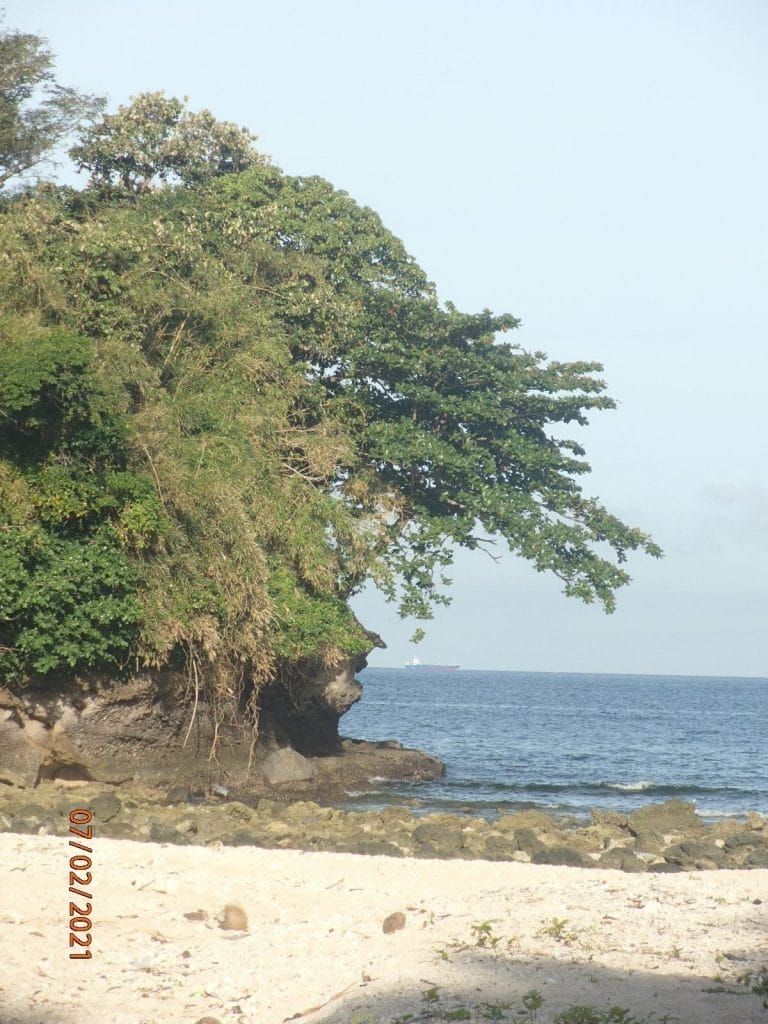
Once back on the mainland, we brainstormed and drew up a short plan for the next actions. The group will urge the PNPCSI board to take on the project of managing the island and proposing a plan that involves beach forest restoration, botanical research, and responsible, sustainable tourism. While the plan is being developed, some short-term actions can already begin. We are coming into summer and this is the best time to reduce the invasive species by girding the larger invasive trees. We had girded two ipil-ipils and we will check their status on the next trip. We had already begun the process of segregating the large pile of trash the caretaker had amassed from the shoreline. Architect Rey plans to use the empty alcohol bottles for a future structure, while all the plastics are now collected into the large fiberglass pool that was once used to catch rainwater. There is still much trash to be collected from the island and either hauled off or put to some use. Walking trails aside from those already present have to be established for future possible geo-tagging of all vegetation as well as a possible future botanical tour. Much more work and plans to be done!
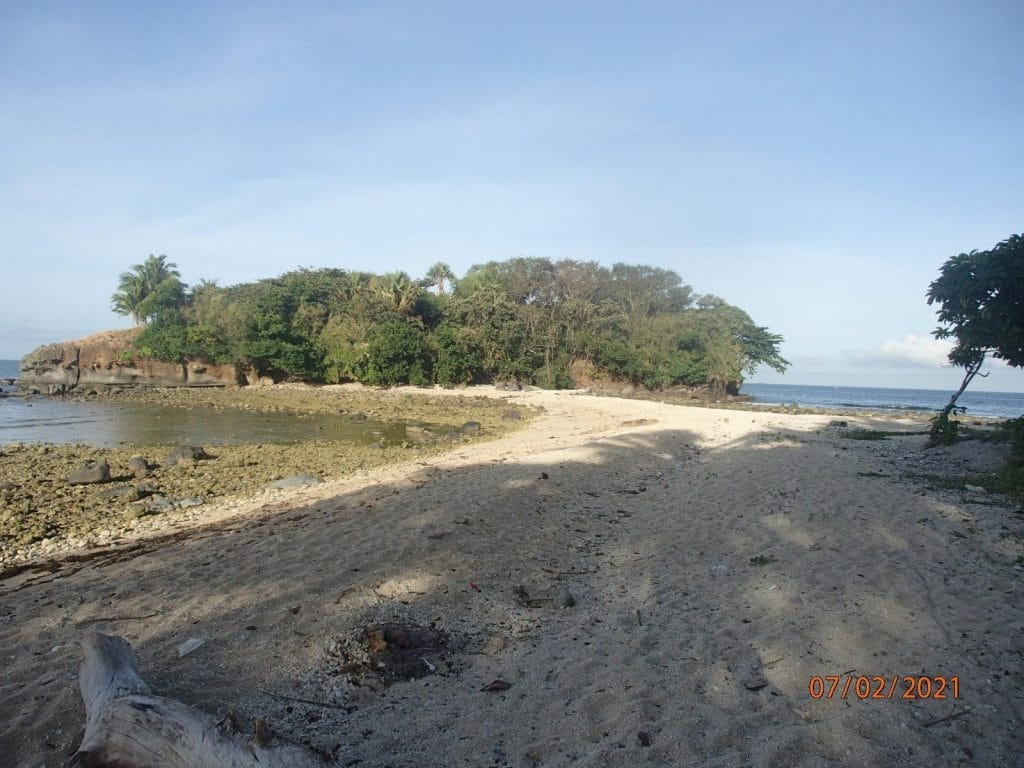
NO. LOCAL NAME BOTANICAL/SCIENTIFIC NAME 1 akleng-parang Albizzia procera (Roxb.) Benth. 2 alagaw Premna odorata Blanco 3 alim Melanolepis multiglandulosa (Reinw.) Reichb.f. & Zoll. 4 anonang Cordia dichotoma Forst.f. 5 aroma** Prosopis juliflora (Swartz) DC. 6 asim-asiman Derris trifoliata Lour. 7 balay-lamok Crataeva religiosa Forst. f. 8 baleteng-liitan Ficus microcarpa L.f. 9 baling-uai Flagellaria indica L. 10 banag Smilax bracteata Presl 11 banago Thespesia populnea (L.) Soland. ex Correa 12 banalo Cordia subcordata Lam. 13 banasi Pouteria obovata (R.Brown) Baehni 14 bangkoro Morinda citrifolia L. 15 bani Milletia pinnata (L.) Panigrahi 16 banyan Ficus microcarpa L.f. 17 bayok Pterospermum diversifolium Bl. 18 beach morning glory Ipomoea pes-caprae (L.) R. Brown 19 bignay-gubat Allophylus cobbe (L.) Raeusch. 20 bikal Schizostachyum diffusum (Blco.) Merr. 21 binayuyo Antidesma ghaesembilla Gaertn. 22 binusisi Tristellateia australasiae A. Rich. 23 bitaog Calophyllum inophyllum L. 24 bolong-eta Diospyros philosanthera Blco. 25 botong Barringtonia asiatica (L.) Kurz 26 buri Corypha utan Lam. 27 camachile* Pithecellobium dulce (Roxb.) Benth. 28 coconut* Cocos nucifera L. 29 coronitas** Lantana camara L. 30 danglin Canavalia cathartica Thouars 31 dilang-butiki Centrosema pubescens Benth. 32 giling-gilingan Abutilon indicum (L.) Sweet 33 hagonoy Chromolaena odorata (L.) R.M. King & H. Rob. 34 halobagat Capparis micracantha DC. 35 himbabao Broussonetia luzonica (Blco.) Burr. 36 ipil-ipil** Leucaena leucocephala (Lam.) de Wit 37 Japanese acacia** Acacia auriculiformis A. Cunn. ex Benth. 38 kabatiti Luffa cylindrica (L.) M. Roem. 39 kalios Streblus asper Lour. 40 kalumpang Sterculia foetida L. 41 kamagong Diospyros blancoi A. DC. 42 kamuning Murraya paniculata (L.) Jack 43 kaong Arenga pinnata (Wurmb) Merr. 44 kautingan Ficus pedunculosa Miq. 45 kayomkom Ixora philippinensis Merr. 46 lagunding dagat Vitex trifolia L. 47 lanete Wrightia pubescens R.Br. 48 langil Albizia retusa Benth. 49 laningning Ficus cumingii Miq. 50 laniti Wrightia pubescens R. Brown 51 mahogany Swietenia macrophylla King 52 makahiya** Mimosa pudica L. 53 malakalumpang Sterculia ceramica R. Brown 54 mambog Mitragyna diversifolia (Wall. ex G. Don) Havil. 55 mango tree Mangifera indica L. 56 mangotngot Clerodendrum inerme (L.) Gaertn. 57 molave Vitex parviflora Juss. 58 morning glory Ipomoea purpurea (L.) Lam. 59 neem tree Azadirachta indica A. Juss. 60 pandakaki Tabernaemontana pandacaqui Poir. 61 pandan Pandanus tectorius Soland. 62 payong-payongan Tacca palmata Blume 63 pingka-pingka Oroxylum indicum (L.) Kurz 64 prickly narra Pterocarpus indicus Willd. forma echinatus (Pers.) Rojo 65 pukinggan Clitoria racemosa G. Don 66 rangoon creeper Quisqualis indica L. 67 rarang Erythrina subumbrans (Hassk.) Merr. 68 sampalok* Tamarindus indica L. 69 santing** Calopogonium mucunoides Desv. 70 sea side plum* Ximenia americana L. 71 seashore ardisia Ardisia squamulosa Presl. 72 smooth narra Pterocarpus indicus Willd. forma indicus Pers. 73 tabon-tabon Guettarda speciosa L. 74 tagpo Ardisia squamulosa Presl. 75 talisai Terminalia catappa L. 76 taluto Pterocymbium tinctorium (Blco.) Merr. 77 tridax* Tridax procumbens L. 78 Tropical golden shower* Cassia fistula L. 79 uuko** Mikania cordata (Burm.f.) B.L. Rob. 80 waling-waling Batangas Vanda lamellata Lindl. 81 yemane* Gmelina arborea Roxb. |
